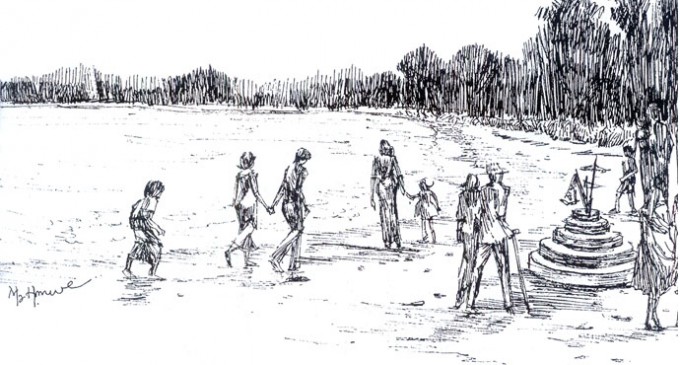TABAUNG : THE MONTH OF SAND PAGODA FESTIVAL

The Myanmar month “Tabaung” in the twelfth and the last month of Myanmar lunar Calendar and coincides with March. Tabaung is the transition period between the late winter and the early summer. Winter covers the first fifteen days i.e from 1st to 15th of the month; summer lasts the latter fifteen days. Days in this month become warm while nights still remain cold. This peculiar change of weather gives rise to our old Myanmar saying – “Hot days and cold night, Tabaung, The unruly month”. (aeYylvdkYncsrf; waygif;v vo&rf;) Being the beginning of spring time, many trees, plants and flowers burst forth into bloom in Tabaung. Among them “Tharaphi (Orchrocapus Siamensis) and “Pon Nyet” (Callo phyllum Inophylum) are traditionally regarded as the flowers of the month.
The word “Tabaung” bears two meaning according to “Wawhara Dipani Kyan” (Book on Vocabulary). The first meaning is that it is the month for longing or yearning because the month is so beautiful and pleasant that one yearns for his loved one. Secondly, it is the month during which jaggery (palm sugar) is made from toddy juice. Of all the Myanmar month Tabaung is chosen to be the most beautiful and pleasant month because the natural landscape bursts forth all its beauties and splendours – i.e. woodlands puts on all hue, brooks wash away fallen leaves, lakes turn emerald green, cuckoos sing to herald summer, some birds (especially sparrows) renovate their nests prior to the advent of monsoon, the cloud and sky show their changing colours and designs.
This poetic Tabaung has made the Myanmar writers, poets and composers of the past and present generation never get bored in praising the beauty of the month. Monk poet Shin Uttama Kyaw of the Innwa Period and prolific poet Pothudaw Oo Minn of the Late Konboung Period who composed the natural beauty of Tabaung in their stanzas are outstanding among other scholars in our Myanmar Literature.
Pothudaw Oo Minn composed the following verse in one of his well known poems.
“This is the time when climbing high,
Orion glitters in the sky.
And shining with the moon at night
Mingles with her’s his yellow light
The sweet scent of the Tharaphee
And faint smell of the Padauk tree
Is wafted from the misty trees
Upon gentle soughing breeze
About the sand banks of the stream
The white arms of a river gleam
I hear the clamorous return
Of wild duck and silver Tern”
“ပန္းေရႊဖီႀကိဳင္ေလွ်ာက္လို႔ ပိေတာက္ကယ္တဲ့ သင္းခ်ဳိ၊ ဥတၱရာဘရဂုဏ္က၊
တိမ္ဘုံမွာ ေရာင္ျခည္လင္းလို႔ လမင္းေသာ္တာႏွင့္ တူမကြာထိန္၀ါလဲ့၊
ထြန္းတဲ့ခါကို။
ေသာင္သဲငယ္မို ေရညိဳ ကရစ္မို႔၊
ေလညင္းငယ္က၊ စုံေဟမာၿမိဳင္ထဲက ၀မ္းဘဲေရႊစင္ေရာ္တို႔
ေဖာ္ေခၚသံ ေမာင္မယ္က်ဴးတယ္၊ ျမဴးေပ်ာ္ၾကလို႔”
The traditional festival of Tabaung is Sand Pagoda Festival. It is assumed that Sand Pagoda Festival were held annually in Tabaung in the Innwa Period according to the earliest historical evidence so far traceable. Like other pagoda festivals Sand Pagoda Festival is also associated with Buddhism. Since Buddhism was well established in Bagan during the reign of King Anawrahta (AD 1044-77), it is possible that Sand Pagoda Festival originated in the time long before the Innwa Period. King Anawrahta built a pagoda “Shwe The Khon” (a&ToJcHk) on the sand bank of the Ayeyarwaddy River. As time went on, its original name “Shwe The Khon” has changed, into “Shwezigon”.
Since Tabaung is the dry season, water in the rivers, streams and lakes recede and sand banks appear instead. Myanmar cultivators grow seasonal crops, such a maize, potato, sweet potato, pears, tobacco, corn, onions, groundnut and other vegetable and fruits on the sand bank. After selling out these agricultural products, they have cash and enough time to spend at the pagoda festivals until the next rain comes. They turn up at the pagoda festivals. Myanmar kings built sand pagodas and held the seasonal festival of Tabaung at the palace as well as at every river side of town and villages. The king, the chief Queen, the princes, the princesses, and the royal attendants came out to pay homage to sand pagoda ceremonially letting the public participate with entertainments and festivities.
Sand pagoda are built up with five tiers, tapering to the top. Each tier of white sand is flanked by bamboo mattings and posts. The five tiers represent five layers of Mt. Meru, the legendary Mountain in Buddhist cosmography. After five layers are filled with white sand, paper streamers and flowers are artistically decorated on them. Sand pagoda last till the next monsoon. Some sand pagoda, were encased in brick and cement to last long. Buddhist devotees come in procession with fruits, flowers and other offertories accompanied by folk dancing, folk song and music troupes. They paid homage to members of the Sangha and sand pagoda with offertories.
Nowadays sand pagoda festival is no longer held country-wide. Only a few towns and village along the rivers hold it annually as their local event. In its place Tabaung festival is held annually at the Shwe- dagon Pagoda, Yangon, on the full-moon day of Tabaung. On the full moon day of Tabaung in 103 Buddhist Era, the Shwedagon Pagoda was built by King Okkalapa to comme-morate its founding date of the pagoda. Tabaung festival is held annually drawing a large crowd of worshippers.
Mg Khaing Zaw
./wp-content/uploads/2018/10/Emirate-Online-TDY.png)
















There are no comments at the moment, do you want to add one?
Write a comment